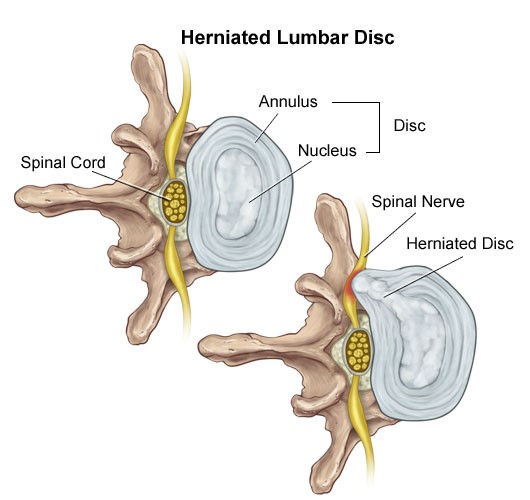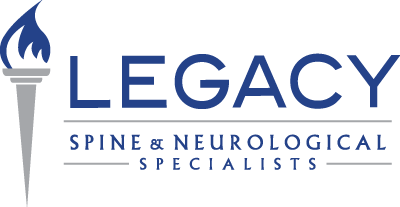Symptoms
Symptoms vary depending on the severity of the condition, and may range from no symptoms to severe pain in the back and or legs with variable degrees of numbness, tingling and weakness in the legs.
Causes
The lumbar discs are the cushions between each of the lumbar vertebrae in the lower back. These cushions are composed of an inner layer of material called the nucleus pulposus, which is surrounded by fibrous bands called the annulus. The nucleus material is a gelatinous core that has the consistency of “boiled shrimp”. These cushions serve as the shock absorbers in our lower back, just like the shock in your car. These “shock absorbers” experience daily wear and tear.

The tissues within the discs age just like every other part of the human body and they carry genetic factors, similar to the genetic factors that determine the rate of hair loss. Both genetics and the aging process apply to the condition and the aging of our discs.
Disc degeneration is normal, with every passing year of life. Everyone has degeneration of his or her discs with time. Degeneration of the discs, annulus and nucleus causes characteristic findings on MRI and X-rays. The report from the radiologist regularly scares patients as it often says that there is “degenerative disease” and annular tears and varying degrees of disc displacement. These findings should not lead to fear or apprehension, as these are all part of the normal changes of life. The phrase “degenerative disc disease” is misleading and should be more properly referred to as the degenerative disc “condition”.
The degenerative condition of the spine therefore is a normal aging process and may or may not be associated with any symptoms. However, several problems involving the nerves passing in close proximity to the intervertebral discs can produce neurological compromise and neurological pain, due to direct pressure on the lumbar nerves. The degeneration process can also affect the joints of the spine called the facet joints. These degenerative changes of the joints and the discs can cause spinal canal and foramen narrowing. The spinal canal is the space that the nerves run down from spinal cord to the legs. The foramen is the window at each level that the nerves run out of the canal and pass to the legs. This narrowing is known as spinal stenosis, which can lead to severe pain down the leg also known as sciatica.
Degenerative discs can lead to a significant weakening of the annulus wall and result in the ability of the nucleus material to squeeze out from its central position to outside of the annular boundary. This can range in severity to mild bulging of this disc nuclear material to a severe complete displacement of the nuclear material outside of the annulus. The latter is also known as a disc herniation. Interesting and inexplicably a disc herniation, even large in size, may be completely without symptoms, or may cause transient mild pain that resolves on its own or it may lead to intractable severe sciatic pain that may lead to surgical treatment. No one in neurosurgery understands why the same MRI finding can lead to such a variable degree of symptoms. Studies have shown that a large percent of adults have completely asymptomatic degenerative findings as well as disc herniation when subjected to an MRI.

Diagnosis
Diagnosis of disc conditions including disc herniation are best made by clinical history and exam coupled by MRI images. Due to resolution limitations of open MRI scanners these should be avoided. One should select a high resolution 1.5 Tesla MRI scanner.
Treatment
Treatment for symptomatic degenerative disc conditions should be of a conservative nature only causing lower back pain without sciatica. Surgery just does not have any statistically significant success for back pain only.
Conservative care may include therapy, NSAID’s neuropathic medication such as gabapentin, spinal injection treatments and chiropractic treatments.
Surgical treatment is reserved only for cases in which the disc condition is producing refractory sciatic pain and or neurological dysfunction. Surgery for sciatic pain that fails to respond to the conservative care above can be very beneficial and usually is with minimal risks.
The exact type of surgery depends on the problem being treated.
At Legacy Neuro we are dedicated to the most conservative treatment plan possible including use of the above non-operative options. If surgery becomes necessary we are committed to offering the least invasive surgical options possible for the spinal condition.
In a future blog, we will scientifically expose the truth behind the claims of “laser” spine surgery. We warn all of our patients to be very cautious and skeptical when anyone declares they can cure you of your back pain with such things as laser beams and decompression tables.

